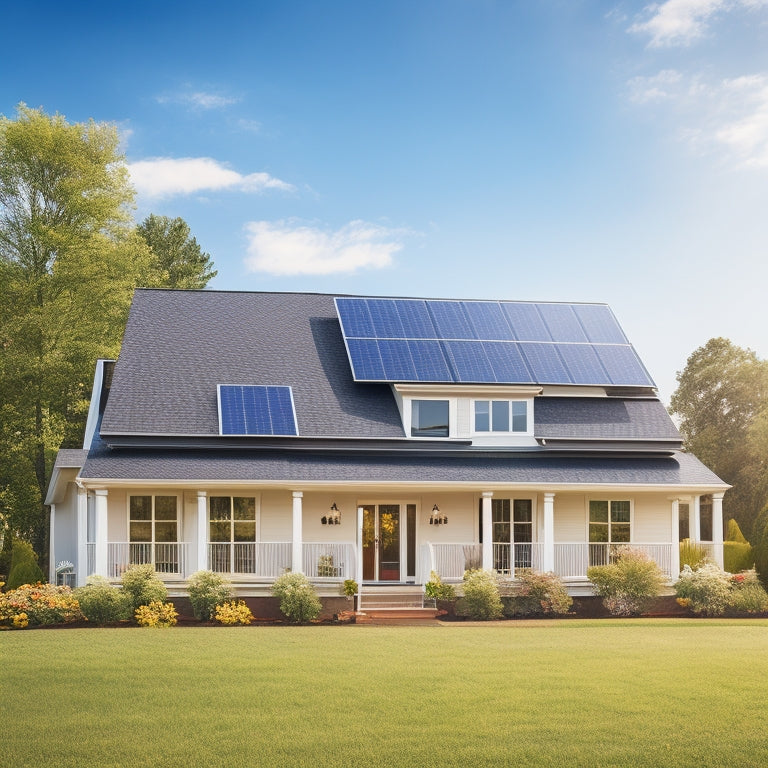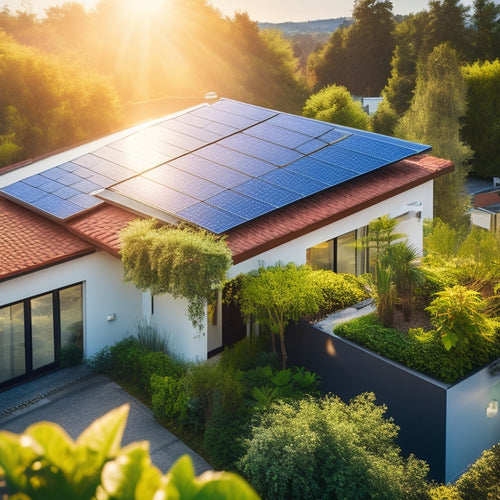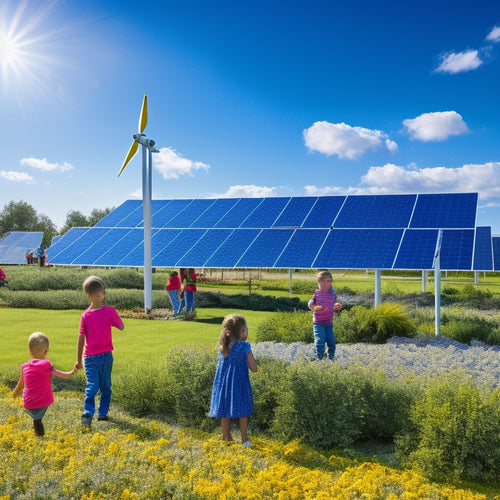
How to Buy and Install Solar Panels in 10 Easy Steps
Share
To buy and install solar panels in 10 easy steps, start by determining your energy needs, evaluating your roof's condition, and choosing the right solar panels. Next, select a reputable installer, check local building codes, and prepare your roof for installation. Then, install the solar panel system, connect to the grid or battery, and monitor and maintain performance. Make certain you evaluate energy requirements, roof compatibility, and panel efficiency, and prioritize high-efficiency panels. By following these steps, you'll be on your way to utilizing the power of the sun - and if you want to optimize your energy environment, there's more to investigate ahead.
Key Takeaways
- Determine your energy needs by calculating past consumption and considering future projections to ensure the solar panel system meets your requirements.
- Assess your roof's condition, material, and orientation to ensure it can support the solar panel system and provide optimal sunlight exposure.
- Choose the right solar panels based on energy requirements, efficiency ratings, and cost versus benefits, considering factors like warranty and long-term savings.
- Select a reputable installer by evaluating their qualifications, customer feedback, and financing options, and ensuring they provide a detailed proposal and necessary permits.
- Monitor and maintain your solar panel system's performance by tracking energy production, consumption, and storage, and addressing troubleshooting issues promptly.
Determine Your Energy Needs
Considering your current energy usage is essential to determining the right size and number of solar panels for your needs.
You'll want to calculate your energy consumption in kilowatt-hours (kWh) to get an accurate estimate. Review your past utility bills to determine your average daily energy usage. You can also use online tools or consult with a professional to help you calculate your energy consumption.
When calculating your energy needs, consider your future projections as well.
Will you be adding more appliances or devices that will increase your energy consumption? Are you planning to switch to energy-efficient appliances that will reduce your consumption?
Take these factors into account to guarantee you install a solar panel system that meets your current and future energy needs.
Assess Your Roof's Condition
How does your roof stack up when it comes to hosting a solar panel system? Evaluating your roof's condition is essential to guarantee a successful solar panel installation.
You'll need to take into account various factors, including roof materials, weather considerations, insulation impact, shading analysis, roof orientation, and maintenance accessibility. Here's a breakdown of what to analyze:
| Roof Factor | Considerations |
|---|---|
| Materials | Asphalt shingles, metal, or tile? Each material has its own installation requirements. |
| Weather | Local weather patterns, such as high winds or hail, can affect solar panel durability. |
| Shading | Trees, chimneys, or neighboring buildings can cast shadows, reducing energy output. |
Choose the Right Solar Panels
You'll need to select solar panels that meet your energy requirements and provide ideal performance.
To do this, you'll want to evaluate the panel's efficiency rating, which affects how much power it can generate per hour of sunlight.
Panel Efficiency Matters
Enhancing your solar panel system's overall performance hinges on selecting the right panels, and that begins with understanding panel efficiency.
You see, panel efficiency refers to how well a solar panel converts sunlight into usable energy. Higher efficiency means more energy output per unit area, making it an essential factor in determining your system's overall energy output.
When it comes to solar panel types, you'll encounter monocrystalline, polycrystalline, and thin-film panels. Monocrystalline panels boast the highest efficiency rates, typically ranging from 15% to 20%.
Polycrystalline panels follow closely, with efficiencies between 12% and 15%. Thin-film panels, while more budget-friendly, have lower efficiencies, usually around 7% to 14%.
To maximize your energy output, prioritize high-efficiency panels, especially if you have limited roof space.
However, keep in mind that high-efficiency panels often come with a higher price tag. Weigh your options carefully, considering factors like energy output, cost, and warranty when selecting the right solar panels for your system.
Assess Your Energy Needs
Before selecting the right solar panels, it's essential to determine your energy needs. You need to evaluate how much energy you consume daily to choose the right system size and configuration. Review your past electricity bills to calculate your average daily energy usage in kilowatt-hours (kWh).
Consider your energy-intensive appliances, such as refrigerators, air conditioners, and electric vehicles. You'll want to maximize your energy independence and environmental benefits by sizing your solar panel system correctly.
By doing so, you'll also optimize your financial savings from solar incentives. Keep in mind that larger systems may require higher installation costs, but they can provide greater long-term benefits.
Consider incorporating battery storage to guarantee grid reliability and sustainability practices. Don't forget to factor in maintenance tips and technology advancements when selecting your solar panels.
Select a Reputable Installer
Three bids from different installers are typically recommended to confirm you're getting a fair deal. This allows you to compare prices, services, and qualifications. When evaluating installers, consider their qualifications, such as energy efficiency certifications and installation training. Check their customer reviews and ask about installation warranties and post-installation support.
| Installer Qualifications | What to Look For |
|---|---|
| Energy Efficiency Certifications | NABCEP certification, energy auditor certification |
| Installation Training | OSHA training, manufacturer-sponsored training |
| Customer Reviews | Positive reviews on Yelp, Google, or Angie's List |
Additionally, inquire about financing options and local incentives that may be available. Be sure to ask about their equipment sourcing and installation timelines. A reputable installer will provide you with a detailed proposal outlining the scope of work, timeline, and pricing. By doing your due diligence, you'll be confident in your choice of installer and confirm a successful solar panel installation.
Check Local Building Codes
Once you've selected a reputable installer, it's time to confirm your solar panel installation complies with local building codes and regulations.
You'll need to research and understand the local regulations that govern solar panel installations in your area. Your installer should be familiar with these compliance requirements, but it's vital you're informed as well.
Zoning restrictions, for instance, may dictate the size and placement of your solar array. Verify your installation meets the necessary safety standards, such as electrical and fire safety codes.
You'll also need to understand the inspection processes and what to expect during the installation process. Your installer should provide you with installation guidelines that outline the scope of work, timelines, and expected outcomes.
Obtain Necessary Permits
Several permits are typically required before commencing your solar panel installation.
You'll need to submit a permit application to your local government, which will review your project to guarantee it meets local regulations and zoning laws. This step is vital, as it affects your installation timeline and eligibility for solar incentives.
You'll need to provide detailed plans and specifications of your solar panel system, including the type and number of panels, the installation method, and the expected environmental impact.
Your contractor can collaborate with you to gather the necessary documents and submit the application.
Once your application is approved, you'll receive a permit that outlines the inspection requirements for your project.
These inspections will verify that your installation meets local building codes and safety standards.
Be sure to factor in the time and cost of these inspections when planning your project.
Prepare Your Roof for Installation
You'll need to assess your roof's condition to verify it can support the weight of the solar panels and withstand various weather conditions.
Next, you'll want to check the structural integrity of your roof to confirm it can handle the added load.
Roof Condition Assessment
Three key factors determine a roof's suitability for solar panels: its age, material, and condition.
You'll want to evaluate these factors to guarantee your roof can support the weight and lifespan of your solar panels. Solar panels typically have a lifespan of 25-30 years, so it's vital to take into account the age of your roof. If your roof is nearing the end of its lifespan, it may be wise to replace it before installing solar panels.
The roof material is also significant. Some materials, like asphalt shingles, are compatible with solar panels, while others, like clay or slate tiles, may require additional installation considerations.
You'll need to verify the roof material can support the weight and attachment of the solar panels.
Lastly, inspect your roof's condition for any signs of wear, damage, or necessary repairs. Look for curled, buckled, or missing shingles, as well as signs of rot or sagging.
Make any necessary repairs before installing solar panels to guarantee a secure and efficient installation. By evaluating these factors, you'll be able to determine if your roof is ready for solar panels.
Structural Integrity Check
Your roof's structural integrity is the foundation of a successful solar panel installation. It's vital to guarantee your roof can support the weight of the solar panels, mounting system, and other equipment. A structural assessment is necessary to determine your roof's load capacity and identify any potential issues.
| Roof Component | Inspection Criteria | Acceptable Conditions |
|---|---|---|
| Roof Framing | Check for signs of rot, damage, or deterioration | Solid, undamaged wood or metal framing |
| Roof Decking | Inspect for water damage, sagging, or unevenness | Flat, even, and securely fastened decking |
| Roofing Materials | Evaluate condition, age, and integrity | Intact, watertight, and securely fastened roofing materials |
During the structural integrity check, you'll need to inspect your roof's framing, decking, and roofing materials. Look for signs of damage, rot, or deterioration, and guarantee all components are securely fastened and in good condition. If you're unsure about any aspect of your roof's structural integrity, consider consulting a professional. Remember, a solid roof is essential for a safe and efficient solar panel installation.
Energy Efficiency Analysis
With a structurally sound roof in place, it's now time to optimize your roof's energy efficiency before installing solar panels.
This step is essential since solar panels work best when they're generating power for an energy-efficient home.
Conduct an energy efficiency analysis to identify areas where energy consumption can be reduced.
Check for air leaks, inspect insulation, and consider upgrading to energy-efficient windows.
These improvements won't only reduce your energy consumption but also increase the effectiveness of your solar panels.
Install the Solar Panel System
Mount the solar panel system on your roof or in your yard, guaranteeing a secure and level installation. This involves attaching the solar panels to a racking system, which is typically made of aluminum or stainless steel.
The racking system must be compatible with your roof type and solar panel types, such as monocrystalline or polycrystalline. Ascertain the system is grounded and securely fastened to prevent damage from wind or weather.
Next, connect the solar panels to an inverter, which converts DC power to AC power for your home. The inverter should be compatible with your solar panel system and installed in a shaded area to prevent overheating.
Installation costs vary depending on the complexity of the installation, roof size, and local labor costs. On average, installation costs range from $2.50 to $3.50 per watt, with a typical residential system costing around $15,000 to $20,000.
Connect to the Grid or Battery
One crucial step remains in the solar panel installation process: connecting your system to the grid or a battery. This connection enables you to capture the power generated by your solar panels and employ it to meet your energy needs.
You have two primary options for connection: grid connection or battery storage. A grid connection allows you to sell excess energy back to the utility company and offset your energy bills. This option is ideal for those who want to reduce their reliance on the grid but still have access to it when needed.
On the other hand, battery storage enables you to store excess energy generated by your solar panels for later use. This option is suitable for those who want to be completely off-grid or have a backup power source during outages.
Regardless of the option you choose, it's important to verify that your system is properly sized and installed to maximize energy production and efficiency.
Monitor and Maintain Performance
Monitoring your solar panel system's performance is vital to confirm it's functioning at ideal levels. You'll want to track your energy production, consumption, and storage to guarantee you're getting the most out of your investment.
Performance monitoring allows you to identify areas for improvement, optimize energy usage, and make data-driven decisions for system upgrades.
Regular maintenance is important to maximize efficiency. Check your inverter regularly to verify it's functioning correctly, and perform seasonal adjustments to optimize energy production.
Keep an eye out for troubleshooting issues, such as faulty panels or inverters, and address them promptly to prevent energy losses.
Efficiency tracking is key to optimizing your system's performance. Keep a record of your energy production and consumption to identify patterns and areas for improvement.
Frequently Asked Questions
Can I Install Solar Panels on a Metal or Tile Roof?
You can install solar panels on a metal or tile roof, but you'll need to contemplate metal roof considerations, such as ensuring a secure attachment, and verify tile roof compatibility with the panel's mounting system to avoid damage.
Will Solar Panels Increase My Property Value?
When you're in the driver's seat, making a solar investment can be a smart move, as it'll likely give your property appraisal a lift, increasing your property value and putting more money in your pocket down the line.
Do Solar Panels Work During Power Outages?
During power outages, you'll want a backup plan since standard solar panels won't function; however, you can opt for solar panel systems with battery storage, which guarantee continued energy supply and enhance solar panel efficiency as reliable power outage solutions.
Can I Install Solar Panels Myself to Save Money?
You're considering taking the reins on a DIY installation to maximize cost savings, but before you start, carefully weigh the risks and rewards, ensuring you're equipped to handle the technical intricacies and potential safety hazards.
Are Solar Panels Resistant to Hail and Extreme Weather?
You're wondering if solar panels can withstand harsh weather conditions. Rest assured, most solar panels are designed to resist hail impact and demonstrate excellent weather durability, ensuring your energy generation remains unaffected by extreme weather events.
Conclusion
You've taken the leap towards utilizing the sun's power! With your new solar panel system, you're not only reducing your carbon footprint but also investing in a brighter, more sustainable future. As you bask in the glow of renewable energy, remember that your eco-friendly decision will have a ripple effect, inspiring others to follow in your footsteps. Now, sit back, relax, and let the sun do the rest!
Related Posts
-

Solar Power Systems for Cost-Effective Sustainability
Investing in solar power systems is a smart move for cost-effective sustainability. You can save about $1,500 annuall...
-

Solar Power for Community Energy Independence
Solar power is essential for your community's energy independence, offering both environmental and economic benefits....
-

Integrating Smart Technology for Energy Savings
Integrating smart technology into your home is a transformative factor for energy savings. Smart thermostats give you...


